Monstrous-mind - The Monster Mind

More Posts from Monstrous-mind and Others

NASA’s TESS Mission Hopes to Find Exoplanets Beyond Our Solar System : The worlds orbiting other stars are called “exoplanets,” and they come in a wide variety of sizes, from gas giants larger than Jupiter to small, rocky planets about as big around as Earth or Mars. This rocky super-Earth is an illustration of the type of planets future telescopes, like NASA’s TESS, hope to find outside our solar system. (via NASA)

What's Up - December 2017
What’s Up For December? Geminid and Ursid meteor showers & winter constellations!

This month hosts the best meteor shower of the year and the brightest stars in familiar constellations.

The Geminds peak on the morning of the 14th, and are active from December 4th through the 17th. The peak lasts for a full 24 hours, meaning more worldwide meteor watchers will get to see this spectacle.

Expect to see up to 120 meteors per hour between midnight and 4 a.m. but only from a dark sky. You’ll see fewer after moonrise at 3:30 a.m. local time.

In the southern hemisphere, you won’t see as many, perhaps 10-20 per hour, because the radiant never rises above the horizon.

Take a moment to enjoy the circle of constellations and their brightest stars around Gemini this month.

Find yellow Capella in the constellation Auriga.

Next-going clockwise–at 1 o'clock find Taurus and bright reddish Aldebaran, plus the Pleiades.

At two, familiar Orion, with red Betelguese, blue-white Rigel, and the three famous belt stars in-between the two.

Next comes Leo, and its white lionhearted star, Regulus at 7 o'clock.

Another familiar constellation Ursa Major completes the view at 9 o'clock.

There’s a second meteor shower in December, the Ursids, radiating from Ursa Minor, the Little Dipper. If December 22nd and the morning of December 23rd are clear where you are, have a look at the Little Dipper’s bowl, and you might see about ten meteors per hour. Watch the full What’s Up for December Video:
There are so many sights to see in the sky. To stay informed, subscribe to our What’s Up video series on Facebook. Make sure to follow us on Tumblr for your regular dose of space: http://nasa.tumblr.com.

(via 500px / …… by Fabrizio Riccardo Castorina)



Der Baum im Herbstlicht & Das Leuchten des Waldes by Oliver Henze
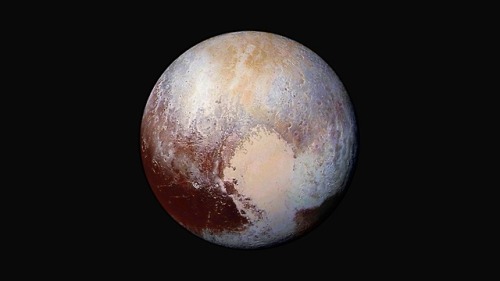

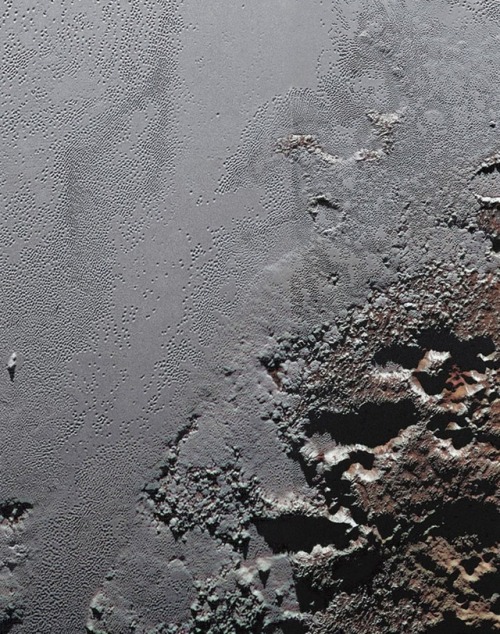
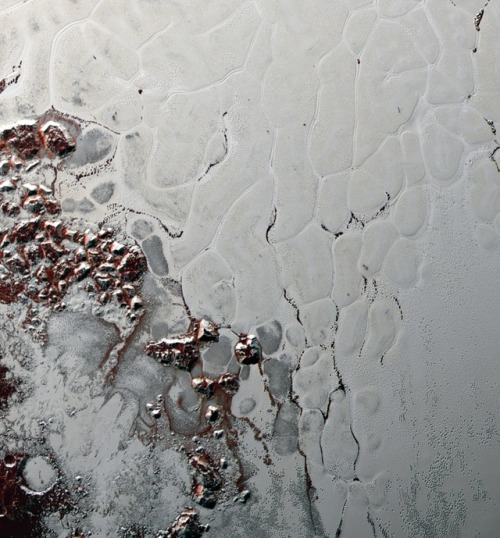
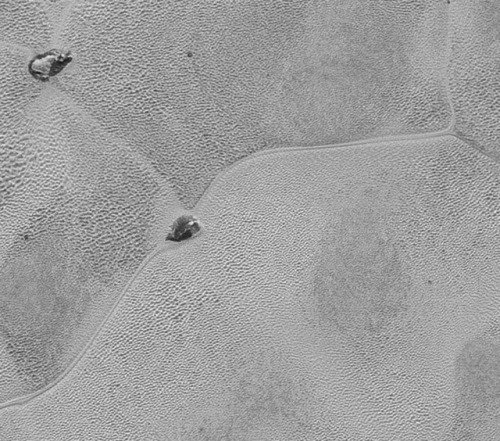
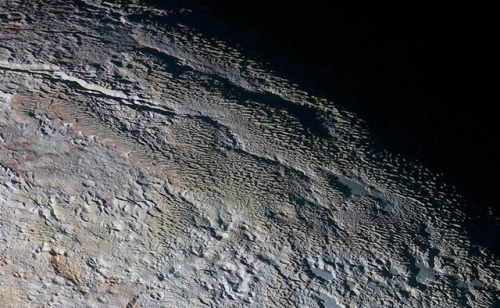
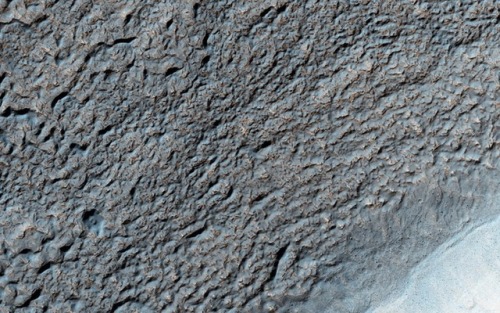
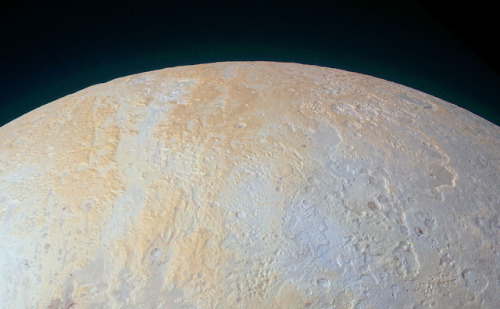
High-resolution images of Pluto taken by NASA’s New Horizons spacecraft.
The plains on Pluto’s surface are composed of more than 98 percent nitrogen ice, with traces of methane and carbon monoxide. Nitrogen and carbon monoxide are most abundant on the anti-Charon face of Pluto (around 180° longitude, where Tombaugh Regio’s western lobe, Sputnik Planitia, is located), whereas methane is most abundant near 300° east. The mountains are made of water ice. Pluto’s surface is quite varied, with large differences in both brightness and color. Pluto is one of the most contrastive bodies in the Solar System, with as much contrast as Saturn’s moon Iapetus. The color varies from charcoal black, to dark orange and white. Pluto’s color is more similar to that of Io with slightly more orange and significantly less red than Mars. Notable geographical features include Tombaugh Regio, or the “Heart” (a large bright area on the side opposite Charon), Cthulhu Macula, or the “Whale” (a large dark area on the trailing hemisphere), and the “Brass Knuckles” (a series of equatorial dark areas on the leading hemisphere). Sputnik Planitia, the western lobe of the “Heart”, is a 1,000 km-wide basin of frozen nitrogen and carbon monoxide ices, divided into polygonal cells, which are interpreted as convection cells that carry floating blocks of water ice crust and sublimation pits towards their margins; there are obvious signs of glacial flows both into and out of the basin. It has no craters that were visible to New Horizons, indicating that its surface is less than 10 million years old.
source | images: NASA/JPL
🍁🍂🎃🍂🍁🌬🌨






Autumn dressed up in gold, is the richest season of the soul.
🔭🌃🌌

Ocean on the moon Europa
Scientists' consensus is that a layer of liquid water exists beneath Europa's surface, and that heat from tidal flexing allows the subsurface ocean to remain liquid.

Europa's surface temperature averages about 110 K (−160 °C; −260 °F) at the equator and only 50 K (−220 °C; −370 °F) at the poles, keeping Europa's icy crust as hard as granite. The first hints of a subsurface ocean came from theoretical considerations of tidal heating (a consequence of Europa's slightly eccentric orbit and orbital resonance with the other Galilean moons). Galileo imaging team members argue for the existence of a subsurface ocean from analysis of Voyager and Galileo images.

The most dramatic example is "chaos terrain", a common feature on Europa's surface that some interpret as a region where the subsurface ocean has melted through the icy crust.
The thin-ice model suggests that Europa's ice shell may be only a few kilometers thick. However, most planetary scientists conclude that this model considers only those topmost layers of Europa's crust that behave elastically when affected by Jupiter's tides.

The Hubble Space Telescope acquired an image of Europa in 2012 that was interpreted to be a plume of water vapour erupting from near its south pole The image suggests the plume may be 200 km (120 mi) high, or more than 20 times the height of Mt. Everest.
Life?
So far, there is no evidence that life exists on Europa, but Europa has emerged as one of the most likely locations in the Solar System for potential habitability. Life could exist in its under-ice ocean, perhaps in an environment similar to Earth's deep-ocean hydrothermal vents. Even if Europa lacks volcanic hydrothermal activity, a 2016 NASA study found that Earth-like levels of hydrogen and oxygen could be produced through processes related to serpentinization and ice-derived oxidants, which do not directly involve volcanism.

In 2015, scientists announced that salt from a subsurface ocean may likely be coating some geological features on Europa, suggesting that the ocean is interacting with the seafloor. This may be important in determining if Europa could be habitable. The likely presence of liquid water in contact with Europa's rocky mantle has spurred calls to send a probe there.
Missions

Europa Clipper is an interplanetary mission in development by NASA comprising an orbiter. Set for a launch in October 2024, the spacecraft is being developed to study the Galilean moon Europa through a series of flybys while in orbit around Jupiter.

The Europa Lander is a proposed astrobiology mission concept by NASA to Europa, an icy moon of Jupiter. If funded and developed as a large strategic science mission, it would be launched in 2027 to complement the studies by the Europa Clipper orbiter mission and perform analyses on site. NASA's budget for fiscal year 2021 neither mandates nor allocates any funds to the mission leaving its future uncertain.
The objectives of the mission are to search for biosignatures at the subsurface ≈10 cm, to characterize the composition of non-ice near-subsurface material, and determine the proximity of liquid water and recently erupted material near the lander's location.
source
🔭🌃🌌


Galaxy UGC 2885 may be the largest one in the local universe. It is 2.5 times wider than our Milky Way and contains 10 times as many stars. This galaxy is 232 million light-years away, located in the northern constellation of Perseus.
Credit: NASA, ESA, and B. Holwerda (University of Louisville)
-
 calm-the-flame reblogged this · 6 months ago
calm-the-flame reblogged this · 6 months ago -
 c0ldautumnnights reblogged this · 6 months ago
c0ldautumnnights reblogged this · 6 months ago -
 c0ldautumnnights liked this · 6 months ago
c0ldautumnnights liked this · 6 months ago -
 ssweet-dispositionn-up reblogged this · 6 months ago
ssweet-dispositionn-up reblogged this · 6 months ago -
 ssweet-dispositionn-up liked this · 6 months ago
ssweet-dispositionn-up liked this · 6 months ago -
 anabelle56 liked this · 6 months ago
anabelle56 liked this · 6 months ago -
 hallowickit reblogged this · 6 months ago
hallowickit reblogged this · 6 months ago -
 autumnal-glow reblogged this · 6 months ago
autumnal-glow reblogged this · 6 months ago -
 twistedfireball liked this · 7 months ago
twistedfireball liked this · 7 months ago -
 tenthirtyone reblogged this · 7 months ago
tenthirtyone reblogged this · 7 months ago -
 hsunquist2013 liked this · 10 months ago
hsunquist2013 liked this · 10 months ago -
 normalisboring-42 liked this · 10 months ago
normalisboring-42 liked this · 10 months ago -
 louisianahalloween reblogged this · 10 months ago
louisianahalloween reblogged this · 10 months ago -
 lacm-ac liked this · 1 year ago
lacm-ac liked this · 1 year ago -
 onionjuggler reblogged this · 1 year ago
onionjuggler reblogged this · 1 year ago -
 oracleelizabeth reblogged this · 1 year ago
oracleelizabeth reblogged this · 1 year ago -
 cataradical liked this · 1 year ago
cataradical liked this · 1 year ago -
 memebae1719 liked this · 1 year ago
memebae1719 liked this · 1 year ago -
 d3xbot reblogged this · 2 years ago
d3xbot reblogged this · 2 years ago -
 la-bestia-de-las-weas liked this · 2 years ago
la-bestia-de-las-weas liked this · 2 years ago -
 shortforbeverage liked this · 2 years ago
shortforbeverage liked this · 2 years ago -
 d3xbot liked this · 2 years ago
d3xbot liked this · 2 years ago -
 mahou-no-momo reblogged this · 2 years ago
mahou-no-momo reblogged this · 2 years ago -
 galactic-murmaider liked this · 2 years ago
galactic-murmaider liked this · 2 years ago -
 hufflepuff1984 liked this · 2 years ago
hufflepuff1984 liked this · 2 years ago -
 omnichaos31 liked this · 2 years ago
omnichaos31 liked this · 2 years ago -
 whiskzart45 liked this · 2 years ago
whiskzart45 liked this · 2 years ago -
 our-lady-of-venom liked this · 2 years ago
our-lady-of-venom liked this · 2 years ago -
 lilenariinpink reblogged this · 2 years ago
lilenariinpink reblogged this · 2 years ago -
 lilenariinpink liked this · 2 years ago
lilenariinpink liked this · 2 years ago -
 coatlizard liked this · 2 years ago
coatlizard liked this · 2 years ago -
 kyojurouzui liked this · 2 years ago
kyojurouzui liked this · 2 years ago -
 all-things-fandomstuck reblogged this · 2 years ago
all-things-fandomstuck reblogged this · 2 years ago -
 all-things-fandomstuck liked this · 2 years ago
all-things-fandomstuck liked this · 2 years ago -
 magicmadscience liked this · 2 years ago
magicmadscience liked this · 2 years ago -
 jonathan-cranes-mistress-of-fear reblogged this · 2 years ago
jonathan-cranes-mistress-of-fear reblogged this · 2 years ago -
 thedolldiaries reblogged this · 2 years ago
thedolldiaries reblogged this · 2 years ago -
 mylionheart2 reblogged this · 2 years ago
mylionheart2 reblogged this · 2 years ago -
 dreamsilentblue liked this · 2 years ago
dreamsilentblue liked this · 2 years ago -
 yousawthewholeofthemoon reblogged this · 2 years ago
yousawthewholeofthemoon reblogged this · 2 years ago -
 yeewe reblogged this · 2 years ago
yeewe reblogged this · 2 years ago -
 gall99 liked this · 2 years ago
gall99 liked this · 2 years ago
My ambition is handicapped by laziness. -C. Bukowski Me gustan las personas desesperadas con mentes rotas y destinos rotos. Están llenos de sorpresas y explosiones. -C. Bukowski. I love cats. Born in the early 80's, raised in the 90's. I like Nature, Autumn, books, landscapes, cold days, cloudy Windy days, space, Science, Paleontology, Biology, Astronomy, History, Social Sciences, Drawing, spending the night watching at the stars, Rick & Morty. I'm a lazy ass.
222 posts